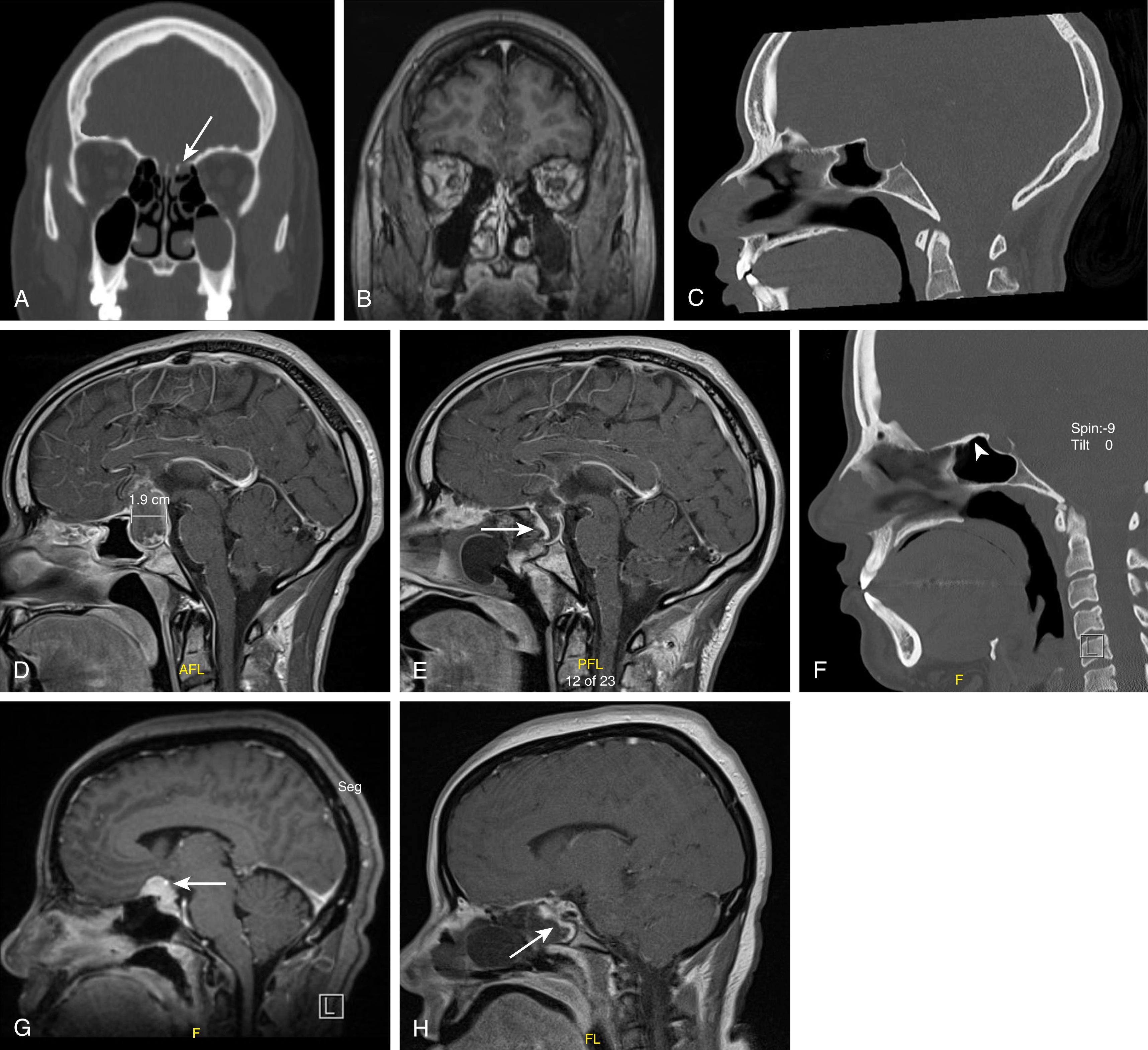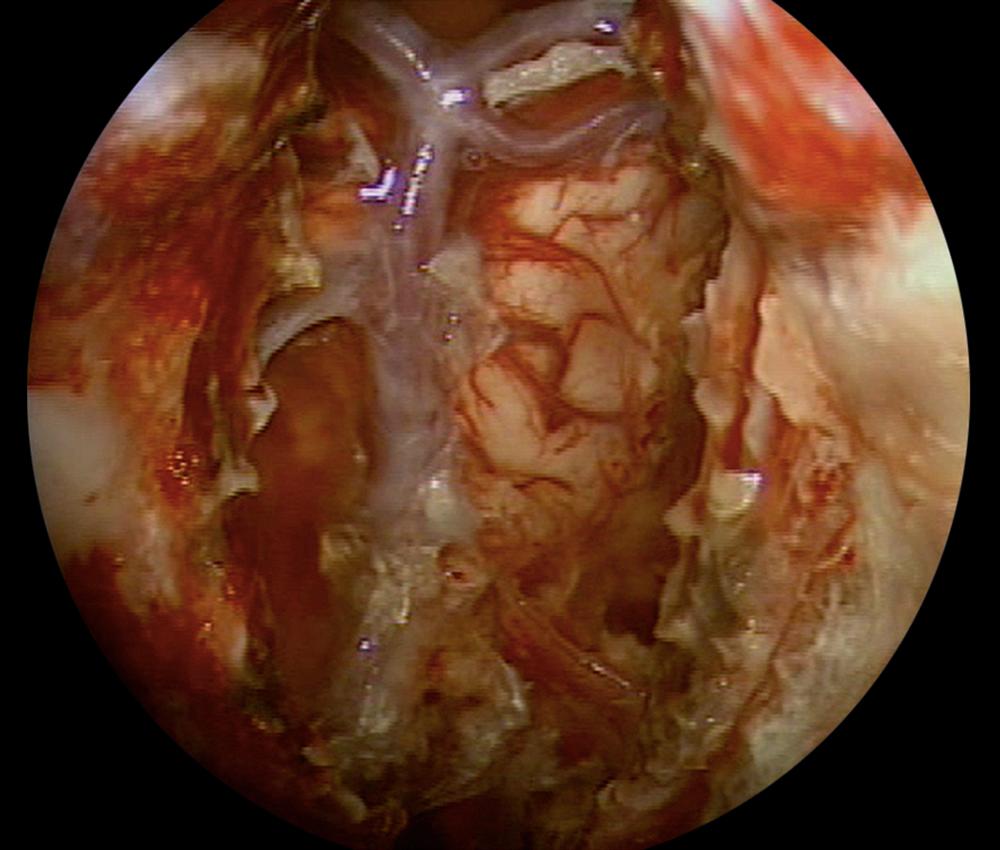Physical Address
304 North Cardinal St.
Dorchester Center, MA 02124
Over the past 15 years, significant improvements in surgical techniques coupled with technological advancements have led to the ability to remove complex skull base tumors using endoscopic endonasal surgery (EES). EES is applicable for a wide variety of surgical pathology, including everything from sinonasal cancers to intradural primary brain tumors. When EES was first developed, proper repair of the skull base and prevention of subsequent cerebrospinal fluid (CSF) leak was one of the primary challenges faced by the surgeon. This review describes how surgical techniques to address these issues have advanced from early free tissue grafting techniques to the current use of vascularized flaps for large skull base defects. We will focus on endoscopic techniques in this chapter.
Open transcranial anterior skull base reconstruction is usually accomplished with an anteriorly based pericranial flap (see Chapter 166 ).
Measuring the size of the defect and attempting to create a smooth surface for repair are vital first steps in all skull base reconstructions.
A multilayered reconstruction with vascular repair is favored over a single layer whenever possible, especially in fields that have previously received or will be receiving radiation therapy.
Postoperative care, including bed rest, bowel regimen, elevation of the head of the bed, and maintenance of airway pressures, plays an important role in successful reconstruction of any skull base defect.
History of present illness
The location of the skull base pathology can possibly be elicited by asking if the patient has any sinonasal complaints, such as nasal obstruction, rhinorrhea, change in their sense of smell, facial pressure/pain, or epistaxis.
Sinonasal etiologies of potential skull base defects often present with nasal obstruction, discharge, or epistaxis. Planar and perisellar etiologies are more likely to present with headache or ophthalmologic symptoms, such as visual field cuts, ophthalmoplegia, or ptosis.
Postoperative CSF leaks are typically noted within a week following sinonasal or skull base surgery. The patient’s history is most suggestive and often diagnostic. Primary symptoms include clear, persistent rhinorrhea with an often salty taste. Postoperative encephaloceles are also potential causes of CSF leak further out from the original surgery.
A history of previous sinonasal, head, and neck or neurosurgical procedures or prior radiation therapy should be elicited.
Vascularized flap reconstruction relies on axial blood flow and tissue planes that may have been disrupted during previous surgeries. Identifying this before the surgery allows for proper planning should the patient require an extranasal flap for reconstruction.
Past medical history
Prior treatment: Does the patient have a known history of skull base pathology? How was this previously treated? Radiation therapy?
Medical illnesses
Prior surgeries: Has the patient ever had endoscopic sinus surgery, a septoplasty, craniotomy, rhytidectomy, or other head and neck surgery?
Family history
Medications:
Antiplatelet drugs
Anticoagulants
Herbal products
Alcohol
Nasal endoscopy
Nasal endoscopy is a key component of the physical examination. It may be limited preoperatively due to tumor or septal deviation. Identifying the size of the tumor and potential involvement of surrounding structures, particularly the septum or rostrum, can be helpful in planning the resection and reconstruction.
Postoperatively, nasal endoscopy plays a vital role in tumor surveillance and helps monitor for potential CSF leaks. In addition to nasal endoscopy, physical examination findings of a CSF leak include a positive reservoir sign and increased rhinorrhea with a Valsalva maneuver. In the early postoperative period, absorbable packing often remains in place, making visualization of the skull base defect difficult. Intermediate timed CSF leaks (2 to 6 weeks) are less common and usually present with intermittent low flow leaks from a pinpoint dural opening. Late CSF leaks (>6 weeks) are very rare and present in a similar manner to intermediate timed leaks. Both the intermediate and late CSF leaks can typically be visualized with a nasal endoscopy.
Orbit
A thorough ophthalmologic examination may reveal tumor involvement of the extraocular muscles, optic nerve, or cranial nerves. While involvement of these structures may not limit the surgical resection, their preoperative function should be noted.
Trigeminal nerve
The path of this cranial nerve and its location in the sinonasal cavity frequently lead to involvement by skull base tumors or injury during resections of these lesions. These nerves will not serve as surgical limits, but their preoperative function provides information as to the size and location of the skull base tumor.
Neck
Sinonasal tumors have a low rate of lymphatic metastasis, but their drainage basins are typically in the cervical lymph node chain, making examination of the neck an important preoperative assessment. Cervical vasculature could also play a role in potential skull base reconstruction depending on the size of the defect or the technique of reconstruction.
Bony anatomy and the extent of skull base involvement are crucial information to obtain during the preoperative assessment. A CT scan can typically provide this detail as well as some information regarding soft tissue involvement ( Fig. 124.1 ). If the planned resection will involve the use of image guidance, proper formatting is required when obtaining these scans.

Skull base tumors frequently abut or involve intracranial structures making soft tissue detail particularly important for proper surgical planning. Other important structures, such as the carotid arteries and optic nerves, must be identified and preserved during skull base procedures. The soft tissue detail that MRI provides is typically the most accurate means of accomplishing this task (see Fig. 124.1 ). The use of contrast can provide excellent detail regarding the vasculature within the skull base and should be included whenever the surgical field will involve vascular structures. Proper formatting should be applied to these scans as well if they are to be used for image guidance during the surgical resection.
Preoperative angiography and intervention play an important role in the treatment of vascular tumors that can involve the skull base, such as juvenile nasopharyngeal angiofibromas. However, its routine use is not necessary in the treatment of most skull base tumors and does not aid in the skull base reconstruction.
Dural defect after the excision of a skull base tumor or encephalocele ( Figs. 124.1 and 124.2 )

Any tumor involving the anterior skull base has the potential to require reconstruction after surgical resection. The size of the defect can often be anticipated based on the preoperative imaging and should be planned for accordingly.
A postoperative CSF leak is identified after sinonasal surgery.
A major complication of endoscopic sinus surgery is damage to the skull base and dura with resultant CSF leak. Injury to the skull base during endoscopic sinus surgery is approached in a similar manner as that of a planned skull base resection.
Large extradural defects to promote healing
Many extradural tumor resections require reconstruction to promote healing, especially in the setting of postoperative radiation therapy. In these situations, the primary reason for reconstruction is not prevention of a CSF leak but is proper healing with the reduction of potential intracranial infections and the protection of vital structures.
Become a Clinical Tree membership for Full access and enjoy Unlimited articles
If you are a member. Log in here